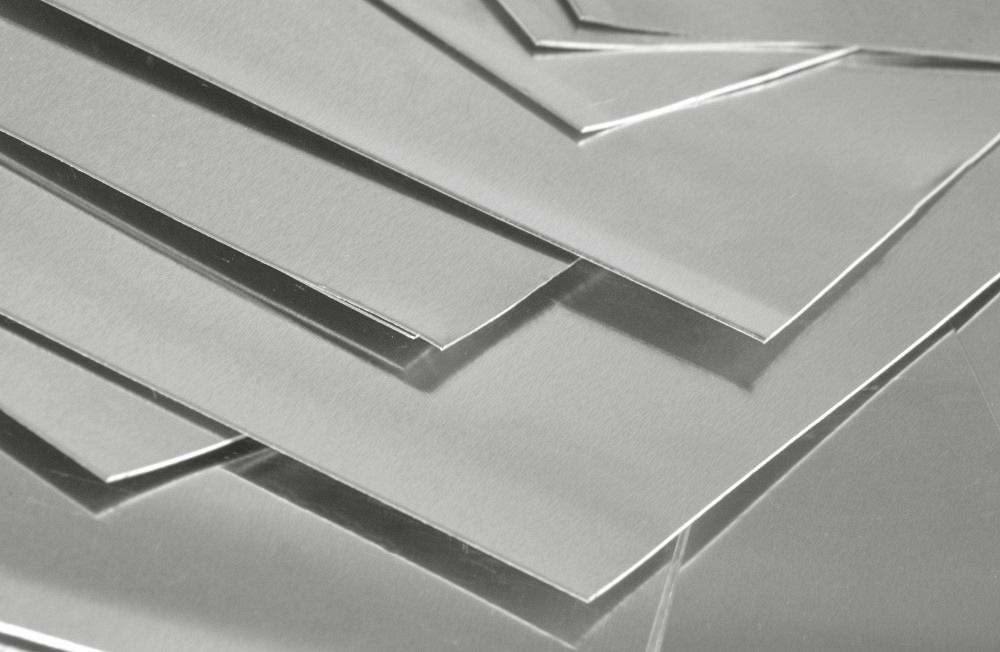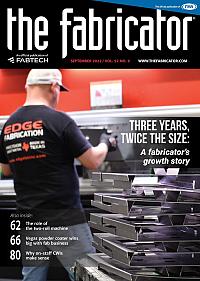- FMA
- The Fabricator
- FABTECH
- Canadian Metalworking
Categories
- Additive Manufacturing
- Aluminum Welding
- Arc Welding
- Assembly and Joining
- Automation and Robotics
- Bending and Forming
- Consumables
- Cutting and Weld Prep
- Electric Vehicles
- En Español
- Finishing
- Hydroforming
- Laser Cutting
- Laser Welding
- Machining
- Manufacturing Software
- Materials Handling
- Metals/Materials
- Oxyfuel Cutting
- Plasma Cutting
- Power Tools
- Punching and Other Holemaking
- Roll Forming
- Safety
- Sawing
- Shearing
- Shop Management
- Testing and Measuring
- Tube and Pipe Fabrication
- Tube and Pipe Production
- Waterjet Cutting
Industry Directory
Webcasts
Podcasts
FAB 40
Advertise
Subscribe
Account Login
Search
How to heat aluminum to avoid cracking after bending
Preventing aluminum from overheating without a digital temperature gun
- By Steve Benson
- September 29, 2022
- Article
- Bending and Forming
Q: I’m building several trash racks to fit over the tops of subdevelopment surface-water-retention pond overflows. I made a simple “pull it around” bending jig using a 0.5-in. steel rod as the die. I received a new order of 0.5-in. rod and heated it with a rosebud. It all pulled around nicely and predictably, producing parts to the desired dimensional accuracy—until, that is, I was about three-quarters through with the task. Suddenly, I could do nothing right, and 90% of the rods were cracking badly. I limped through by welding.
After adjusting my torch heat (if it is too cold, it ain’t gonna bend), I surmised that the only thing that worked is a lot of heat. I must have gotten into some rod stock that was older and had more oxide on it. It all looked pretty new. I used some material that had sat in a rack for 6 to 12 months, but I cannot blame it all on “old stock.”
I thought perhaps I was heating too hot too fast, so I altered that, but with no better results. I would put a little spring tension on the piece, apply heat, and when the piece gave way, I’d slowly, consistently pull it to 90 degrees while keeping the torch on it, making sure not to heat the work excessively. That worked so well that it scared me … until it stopped working.
In one of your past columns, where you covered bending 6061-T6 aluminum, you described using a torch to coat the area being bent with soot. Would this work for my application? What if I wire-brushed the areas to be bent? And would the manual removal of oxide help? Any advice would be much appreciated.
A: Before I get to the soot and aluminum, let’s look at the bending consistency issue. Because I do not know the exact grade and type of steel or aluminum that you may be using to manufacture your trash racks, it is hard to say the specific reason the material is giving you a hard time.
At this point in the conversation, however, it really does not matter. Old material or new material is probably not the issue. Note that each type and grade of metal will randomly exhibit the same variations when subjected to the same processes. So, the repeatability issue is rooted in the fact that no two batches of material are the same—not even batched from the same heat—as the mixing of the base materials is never perfect.
All of the materials you use have tolerance zones around different attributes, including thickness, hardness, yield strength, and tensile strength. This does not mean you sometimes have “poor” material and other times “better” material. The material is just different within its designated tolerance zone and, therefore, will bend differently.
Steel can be categorized according to its yield strength and other factors. For example, the yield strength values can be highly variable depending on impurities in the material, imperfections, and production techniques.
Regulations require a declaration of the minimum yield strength in defining a specific material type. A steel with a minimum yield strength of 36,000 PSI can be labeled as A36. Because no two pieces of material are the same, a variable tolerance must be applied. This can mean that yield strength of 41,000 PSI will still be sold as A36, despite being 13% stronger. This material’s increased resistance to bending will require a greater bending force. The 36,000-PSI yield-strength material will bend to one angle, and another material with a 41,000-PSI yield strength will bend to a lesser angle—without changing the depth of penetration or required bending force (see Figure 1). For the same reason, variations in ductility or hardness, or too small of a bend radius can explain the cracking. These variations are true of any materials you might be using.
Softening or Annealing
Heating will help as it anneals the material, making it softer and therefore easier to bend. It also helps to control the cracking you are encountering.
To heat your material properly, use a torch with a rosebud tip. Also, keep an eye on the temperature and keep heating within reason. For steel, it is 900 to 1,050 degrees F.
By keeping steel between those temperatures, you should be OK where yield and tensile strengths are concerned. However, if you heat the material to between 1,600 and 2,000 degrees F, you will see a significant change in the metal’s temper, which may require the finished piece to be heat-treated back to the required yield/tensile strengths for that workpiece.
How to Measure Temperature in Steel
There are many ways in which to gauge the temperature. As you heat steel, it changes color, which you can compare to a color-to-temperature chart (see Figure 2). If you want to be precise, you can use a digital temperature gauge, which you can find for as little as $30. Just aim at the heated area and read the results.
The Effects of Aluminum Oxide
This now brings us to your question about soot and aluminum. Heating aluminum works just as well as it does with steel, except for a couple of things. First, aluminum does not change color like steel, so getting burned becomes a real issue. And because it doesn’t change color, you can’t compare it to the temperature chart. If you don’t have a digital temperature gauge, what do you do?
Before I answer that question, there is one more heat-related issue to consider if you’re working with sheet metal and plate rather than an aluminum or steel rod: You can blow a hole right through the sheet. You can do this with steel, but you’ll see it coming; with aluminum, you will not. Why? Because of aluminum oxide.
Aluminum oxide’s melting point of 3,600 degrees F is much higher than aluminum’s melting point of 1,220 degrees F. This means the aluminum will melt from the inside out and can blow a hole in the material. And because aluminum doesn’t change color, you won’t see it coming. So, caution and uniformity in heating are a must.
Steel is more forgiving, depending on the steel alloy. The melting point can be as low as 2,599 degrees F for low-carbon steel to 2,786 degrees F for chromium-molybdenum steel. Regardless, steel does change color, so you can judge its temperature and see a blowout coming.
The Case for Soot
If you’re heating aluminum and don’t have a digital temperature gun, how do you keep it from overheating? Here’s where soot enters the picture. Black carbon soot is released when fossil fuel is not completely combusted. You can easily produce black carbon soot simply by detuning the same acetylene torch you are going to be using to heat the part you’re going to bend. Lay a layer of carbon down the inside length of the bend line. Then, retune the torch and begin to heat what will be the outside of the bend, the opposite side from the carbon soot.
The carbon soot will burn off at 752 degrees F; that’s 460 degrees F less than the melting point of aluminum. That’s hot enough to make the aluminum malleable enough to bend easily with no risk of changing the temper or blowing out a hole.
Aluminum Oxide and the Wire Brush
Removing the aluminum oxide is not necessary for forming but can be of assistance when welding. You can scratch it off with a wire brush and then wipe it with a lint-free cloth.
The problem is the reaction between the raw surface of the aluminum and the air begins within just a fraction of a second. Aluminum oxide is only 1.5 µm thick. Stable and mechanically strong, the oxide bonds to the aluminum surface. This then separates the aluminum from any further reaction with the air. Known as passivation, it’s the same process that you would use to maintain the stability of stainless steel or titanium. All of that said, you can remove aluminum oxide briefly, but it will not help to stabilize your forming operation.
About the Author

Steve Benson
2952 Doaks Ferry Road N.W.
Salem, OR 97301-4468
503-399-7514
Related Companies
subscribe now

The Fabricator is North America's leading magazine for the metal forming and fabricating industry. The magazine delivers the news, technical articles, and case histories that enable fabricators to do their jobs more efficiently. The Fabricator has served the industry since 1970.
start your free subscription- Stay connected from anywhere

Easily access valuable industry resources now with full access to the digital edition of The Fabricator.

Easily access valuable industry resources now with full access to the digital edition of The Welder.

Easily access valuable industry resources now with full access to the digital edition of The Tube and Pipe Journal.
- Podcasting
- Podcast:
- The Fabricator Podcast
- Published:
- 04/16/2024
- Running Time:
- 63:29
In this episode of The Fabricator Podcast, Caleb Chamberlain, co-founder and CEO of OSH Cut, discusses his company’s...
- Trending Articles
Tips for creating sheet metal tubes with perforations

Are two heads better than one in fiber laser cutting?

Supporting the metal fabricating industry through FMA

JM Steel triples capacity for solar energy projects at Pennsylvania facility

Omco Solar opens second Alabama manufacturing facility

- Industry Events
16th Annual Safety Conference
- April 30 - May 1, 2024
- Elgin,
Pipe and Tube Conference
- May 21 - 22, 2024
- Omaha, NE
World-Class Roll Forming Workshop
- June 5 - 6, 2024
- Louisville, KY
Advanced Laser Application Workshop
- June 25 - 27, 2024
- Novi, MI





























